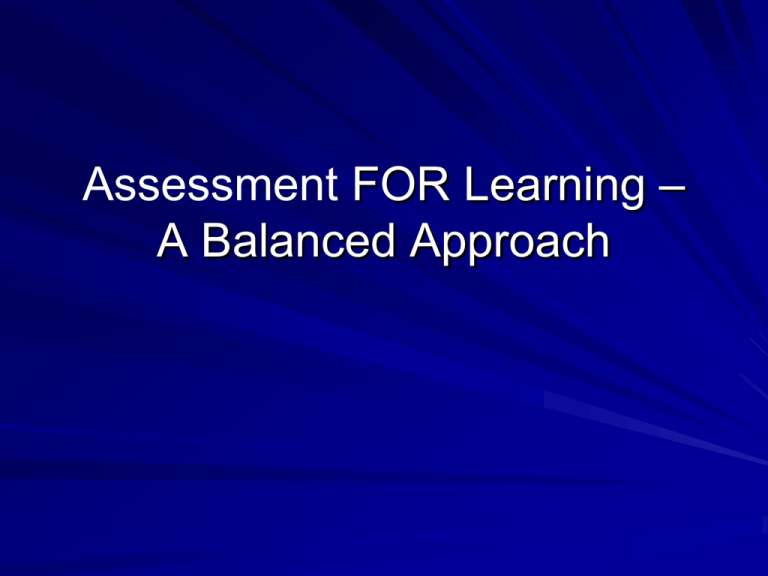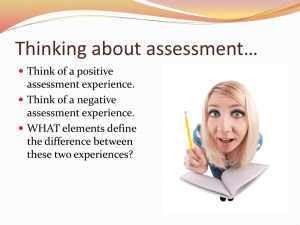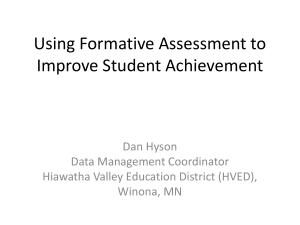Balanced Assessment Systems for Improved Student Learning
advertisement

Assessment FOR Learning – A Balanced Approach Purposes Identify components of a balanced assessment system. Discuss appropriate uses of assessment tools and techniques. Discuss the need for a balanced system to improve student learning. How Are You Assessing? At your table divide into two groups, identify all the assessments you use. With the total group at your table compare and contrast the ways you assess student learning. Identify the most commonly used and the most unique approaches, record on chart paper. Write each type of assessment on a Postit note. Put the Post-it notes aside until later. Shifts in Assessment Practices FROM: Separating successful from unsuccessful learners Primarily summative Focus on large-scale assessments Teacher directed TO: Ensuring universal competence/success Balance of formative and summative Balance large-scale w/ classroom assessment Teacher and student focused Balance Both Sides of Assessment Summative Formative Large-scale Classroom Balanced Assessment System Assessment FOR Learning (Formative) Includes instructionally embedded activities Usually teacher/locally developed Yields rich diagnostic information Happens while material is being taught Informs and focuses instructional decisions Isn’t used for grades Assessment OF Learning (Classroom Summative) Occurs after material is taught Includes unit tests and other graded performances Can be developed locally or purchased Counts toward grades Isn’t diagnostic Benchmark / Interim Assessments Are usually a form of summative assessment Can be used as an early warning of performance on later high stakes tests Often constructed by external sources Can cover some or all of a year’s curriculum Provides broad domain or sub-domain coverage (minimally diagnostic) Results raise programmatic questions that require further investigation (*formative for program – not current student) High Stakes Accountability Tests Provide broad domain or subdomain coverage (minimally diagnostic). Usually constructed by an external source. Results raise programmatic questions that require further investigation. Satisfy accountability requirements – state and federal. Can give the “big picture” view of state and school performance. Three Types of Assessment “(In)formative Assessments,” Harvard Education Letter, 2006 Summative Interim/ Benchmark Formative Key Question Do you understand? (yes or no) Is the class on track for proficiency? What do you understand? When Asked End of unit/ term/year 6 – 10 times per year Ongoing Timing of Results After instruction ends Slight delay Immediate Assessment: Knowledge of Students In-depth knowledge of specific students National Assessments State Assessments District Assessments Classroom Assessments Marzano, 1996 Assessments have various purposes, provide answers to different questions, address different users, and have varying implications for an assessment system. Classroom Assessment User: Student EDge(PDK), 2006 Important Question to be Answered Implications for the Assessment System What am I supposed to learn? Accurate assessments must reflect the learning targets. What have I learned already, and what do I still need to work on? Continuous sequence of accurate CA must provide descriptive feedback in student-friendly terms during learning. Have I met or am I progressing toward the standards? Assessments must provide evidence of mastery throughout the year. Have I met the state achievement expectations? Annual state assessments reporting standards mastered/not yet mastered. Classroom Assessment User: Teacher EDge(PDK), 2006 Decisions to be Made Implications for the Assessment System What are my students supposed to learn? All assessments must reflect these targets; it must be clear which target any assessment reflects. What have they learned already, and what do they still need to learn? Continuous sequence of accurate classroom assessments used during the learning to provide picture of progress toward mastery of standards. Classroom Assessment User: Teacher EDge(PDK), 2006 Decisions to be Made Implications for the Assessment System Which students need special services? Assessments must provide evidence of students’ relative status or progress to determine eligibility. Have my students met or are they progressing on the important achievement standards? Periodic, interim benchmark assessments reflecting student mastery of standards throughout the year. Did they meet state achievement expectations? Annual assessments of each student’s mastery of each state standard. Instructional Support User: Principal, Curriculum Leader, Teacher Teams EDge(PDK), 2006 Decisions to be Made Implications for the Assessment System What standards are students expected to master by subject across our classrooms? Assessments must accurately reflect these standards and classroom learning targets. Which standards are students mastering or progressing toward? Are there problem areas? Comparable evidence of student learning status collected periodically during the year. What standards are students to master across our classrooms, grades, and schools? Assessments must accurately reflect these standards. Did enough of our students meet standards this year? Annual assessments reveal how each student does on each standard. Policy-Level User: Superintendent, Various Policy Makers (EDge, PDK,2006) Decisions Implications for the Assessment System What standards are to be met? Assessments must accurately reflect these standards. Which of these standards are students mastering or making progress toward in what schools? Comparable evidence of student learning status collected periodically during the year. What standards are students expected to master in our schools? Assessments must accurately reflect these standards. How many of our students are meeting standards? Comparable evidence of student learning status collected periodically Did enough of our students meet standards this year? Annual assessments show how each student scored on each standard. Balanced Assessment System “To maximize student success, assessment must be seen as an instructional tool for use while learning is occurring, and as an accountability tool to determine if learning has occurred. Because both purposes are important, they must be in balance.” From Balanced Assessment: The Key to Accountability and Improved Student Learning, NEA (2003) Emotional Dynamics of Assessment Productive Counterproductive Leaves student confident and willing to try Leaves student confused, frustrated, and ready to give up Helpful to teacher if assessment reveals what comes next in learning Leaves teachers with no idea of what to do next Rick Stiggins, 2006 Essential Classroom Assessment Teachers are assessment literate. Classrooms reflect a balanced assessment system. Teachers are skilled users of both formative and summative assessment. Standards are the Foundation for Curriculum, Instruction, and Assessment Identify important learning Manageable in number Clearly articulated Developmentally reachable by students Organized in learning progression Mastered by the teachers Formative Assessment CCSSO FAST SCASS Formative assessment is a process used by teachers and students during instruction that provides feedback to adjust ongoing teaching and learning to improve students’ achievement of intended outcomes. Define Assess Comes from the Latin verb ‘assidere’ meaning ‘to sit with.’ in assessment one is supposed to “sit with” the learner. This implies it is something we do with and for students and not to students. (Green, 1998) Assessment in Support of Learning Assessment quality must address the impact of the results on the learner and the learning. Assessments must: – go beyond merely providing judgments about student performance to providing rich descriptions of student performance. – evolve from being isolated events to becoming events that happen in ongoing series to reveal patterns. – go beyond merely informing instructional decisions of teachers to informing decisions also made by students. Rick Stiggins, 2006 Research?? So, is this just the next new thing? NO! Research soundly tells us that formative assessment can positively impact student learning. The “Black Box” Findings Black and Wiliam’s research indicates that improving student learning through assessments depends upon five factors: – Providing feedback to students – Students’ active involvement in their own learning – Adjusting teaching to take account for results of assessment – Recognizing influence of assessment on students’ motivation and self-esteem – Ensuring students assess themselves and understand how to improve Inside the Black Box: Raising Standards through Classroom Assessment,” KAPPAN, 1998. What Does Formative Assessment Look Like in the Classroom? Clarifying and sharing learning intentions and criteria for success Engineering effective classroom discussions, questions, and learning tasks Providing feedback that moves learners forward Activating students as the owners of their own learning Activating students as instructional resources for one another From “Classroom Assessment: Minute by Minute, Day by Day” Leahy, Lyon, Thompson, Wiliam. 2005. Essential Components Formative assessment is NOT just another test. Formative assessment is NOT about grades. It’s about helping students move along a progression to higher levels of learning. The Learning-Assessment Process A Model of Formative Assessment Where are you now? (assessment goal) Where are you trying to go? (instructional goal) How can you get there? (what is needed to reach instructional goal) From Atkin, Black, & Coffey, Editors; Committee on Classroom Assessment and the National Science Education Standards, Center for Education, National Research Council (2001) Classroom Questions Can be formative or summative. Classroom questions can be closed or open. Can engage students in dialogue to extend learning. Can be used to check for learning (e.g., exit tickets). Closed Questions Teacher has a predetermined correct response. Concerned with the recall of facts; comprehension. “Convergent” assessment aims to discover whether the learners knows, understands, or can do a pre-determined thing. (Torrance and Pryor, 1998) Open Questions Encourage students to think beyond. “Divergent” assessment aims to discover what the learner knows, understands, or can do. (Torrance and Pryor, 1998) Help develop student understanding and thinking. Allow for a range of responses and increasingly challenging cognitive demands. Encourage dialogue. Productive Dialogue Involves: – Challenge – Clarification – Elaboration of ideas – Suggestions – Observations – Reflections Ministry of Education, Wellington, New Zealand Questioning Activity With you group, develop one closed question and one open question. Discuss the value and purpose for each of these. Be prepared to share. Quality Feedback Should… Focus on the learning intention of the task. Occur while the students are doing the learning. Provide information on how, why, and what the student understands and misunderstands. Provide strategies to help the student improve. Assist the student to understand the learning goals. Ministry of Education, Wellington, New Zealand Grades - Comment Research shows that student given only evaluative feedback (grades) made no gains from one lesson to the next. Students given only descriptive feedback (comments) scores an average of 30% higher. Giving grades alongside comments cancelled the beneficial effects of the comments. Wiliam, 1999 Student Involvement Self assessment Peer assessment Increases student engagement and student motivation. Formative Assessment is at the Heart of Instruction Multiple measures, multiple opportunities, frequent Improvement over time Collaborative Informs students of their learning and progress Informs teacher judgment and teaching Directly affects student growth Feedback into teaching and learning Summative Assessment “Sums up” learning. (Black and Wiliam, 1999) “Looks at past achievements…involves only marking and feedback grades to students…is separated from teaching…is carried out at intervals when achievement has to be summarized and reported.” (Harlen, 1998) Measures student learning. Summative Assessment Necessities Used for accountability in the classroom. Assessment tasks must match identified learning targets. Teachers need to know how to develop good measures of student learning. Teachers need to be good consumers of purchased tests. Teachers make the difference.








